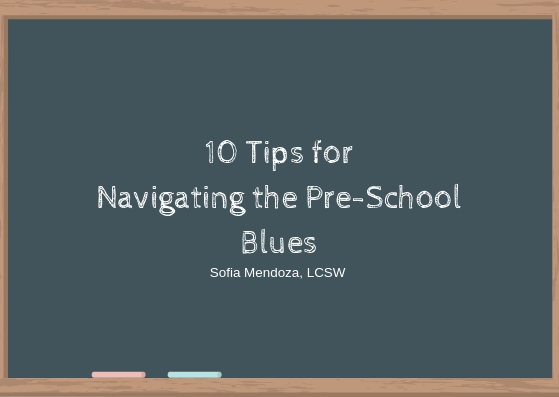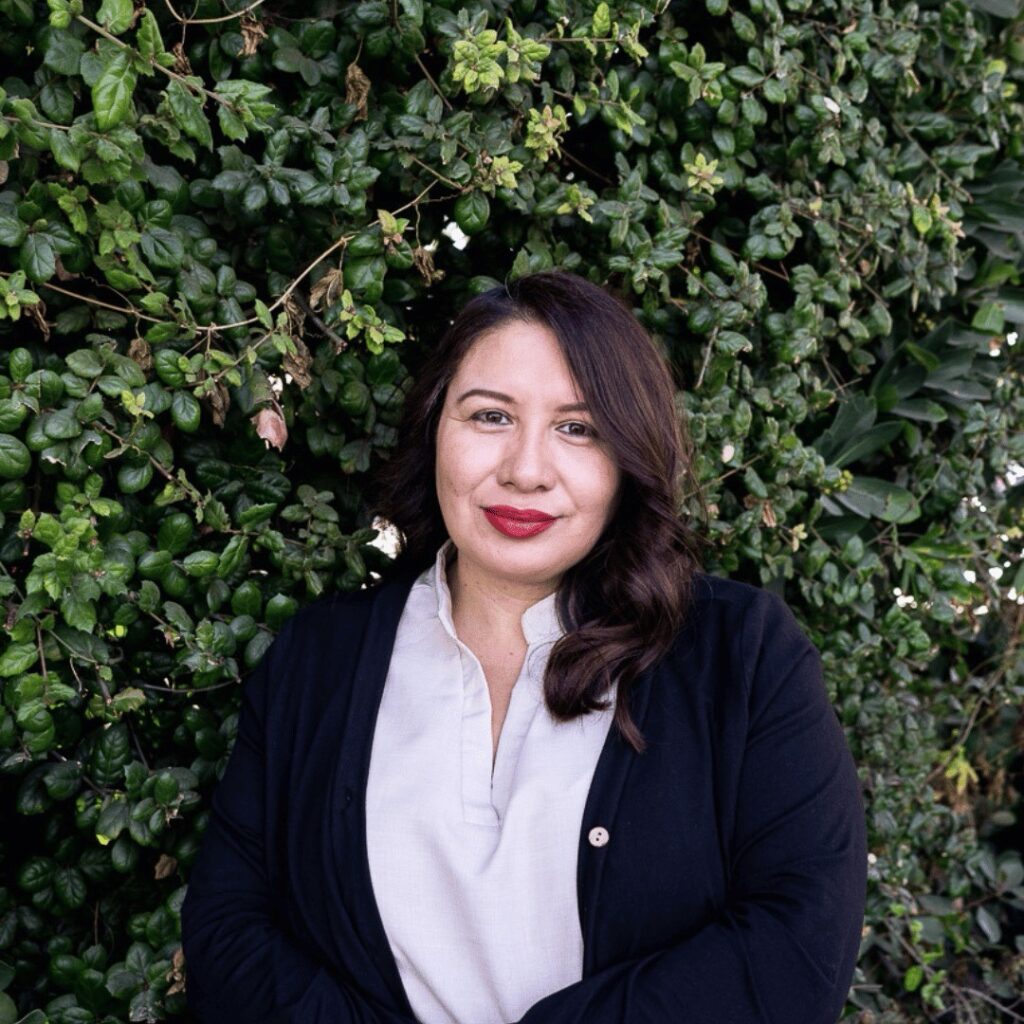Navigating the pre-school blues is a hot ticket topic at home currently. My little one (LO) just started pre-school and it’s triggered so many emotions and catastrophic thoughts for everyone in my family. My LO has been crying at drop off every day. “It was gutting” is what I said to my husband when he asked me how it went. He’s known it too well as he’s the one who primarily drops her off. So I’m writing this post first as a mom, then second as a child therapist.
I started writing this post just as she left the house on day 10 and had yet another crying spell. I’m happy to report that by day 11 (today), she broke the crying spells (so far). My intention was to write the post on how we were managing, not how we got through it. Since today is day 1 of no crying, I’ll stick with how we’re managing.
10 Tips for navigating the pre-school blues:
- Visit the new school several times before start date. This wasn’t fair for my little one (LO). And I knew better. I recommend that there are frequent trips driving to the new school, taking them on a tour of the facility, meet the teachers, staff, etc. My LO was going to start on a Tuesday and she found out/saw the new place on the Friday right before (and after a dr appointment no less). Gradual exposure is the best with separation anxiety.
- Reading books about the transition to pre-school/kindergarten. (Disclosure: some of the links used are Amazon affiliate links where I get a small commission from purchases made from the links. Read more about my disclosure statement below*) Last year my LO started daycare and knowing it was going to be big transition from being at Nana’s everyday, we read “Llama Llama Misses Mama.” It’s such a sweet and heartwarming book. My daughter loved it and it really helped her feel validated. It also helped me understand what a child might be going through when they’re hesitant about starting school. Recently we revisited Llama Llama Misses Mama, and she responded to it in such a different way. We also added to the rotation, “Look out Kindergarten, Here I come“. This book came from my office collection. I used it with children who had such a hard time staying in daycare/school, that they were no longer attending. This book, along with gradual exposure (discussed above) really helped. Both books are great at highlighting the cool and fun things children will do at school. My LO started to draw comparisons between the characters and herself, not only when reading the books, but even when talking about.
3. Comfort or Transitional Object. A transitional object is an object that comes from the child’s home that they take with them to provide comfort, soothing and a sense of security. I had read about it when I was in college, but I saw it in action when my nephew was a baby, he was super attached to his mom’s silky nightgown. Eventually the nightgown was torn and tattered, but he still couldn’t sleep without it. So they cut it and tied it in half so he could sleep with it. When he started school, he took it with him in his backpack. It provided safety and comfort for him. Of course, he’ll deny it if asked, but that’s for another article about teenagers. There’s a wonderful article on transitional objects here. I bought the elastic hairbands (to give away as party favors) below for my daughter’s birthday before starting pre-k. She loved them. A few of her daycare friends attended the party and they all wore the bands on their wrists. Since I had a few left over, five days into pre-school and with her crying daily at drop off and during arts & crafts (she told me this when reading Llama Llama Misses Mama , by the way), I remembered about the hair bands. I gave her one and told her that she could wear the hairband on her wrist and when she’s feeling sad, she can take a look at it and remember that it’s ok to feel sad, and that mommy and papa love her, and would always come back to pick her up around 4:30pm. Because she liked it to begin with, she went for it. A few days later, she lost it and started crying. We got her another one and she was happy about it again. I’d ask her daily if she wanted to leave it at home or continue to wear it and she was always up for wearing it. Comfort objects can be anything from a sticker, a toy, blanket, fabric swatch, stuffed animal. Check with your child’s school about what they can bring with them since many only allow certain toys on certain days (for us, Fridays are “Share Days”).
A note about these hair/wrist bands, you can totally DIY it. Just buy elastic, snip two ends and tie a strong knot. Amazon has tons of elastic in different colors and prints.
4. Mantras. I really love the book below, “I can handle it” because it reinforces the idea that one can have challenging situations with strong feelings and still being able to handle it, all at the same time by first telling yourself, “I can handle it.” The book gives different examples of how to “handle it” such as healthy coping, making good decisions, and telling yourself over and over again, “I can handle it.” Come up with a positive thought about your child’s coping and say it over and over again throughout the days. Some that we used with our LO were “I’m going to make new friends,” “I’m going to learn new things,” “I love recess time,” and “I can feel sad and play with my friends at the same time.”
5. Deep breathing. Deep breathing really helps to reset and soothe our fight and flight response. On week 2, we started having her take deep breaths with one hand on her heart and one on her belly. We’ve watched the videos below hundreds of times on breathing and they’ve totally helped us in remembering to breathe and how to do it.
6. Understanding Anxiety. The “Just Breathe” video above talks a little bit about the brain and the amygdala driving our big emotions. When my LO is feeling scared or sad, I ask her where in her body does she feel it. In that moment, she stops and checks in with her body to see. She usually says she feels in her heart, or her forehead. Then we come up with a plan for how to soothe. The book below is my favorite book on Anxiety. I share it with both children and adults.
7. Praise. Praise is a win-win skill where the parent praises a specific positive behavior in a child. It lets the child know that the parent is paying attention, it makes them feel good about themselves for doing something well, and the parent feels good about catching their child do something well. In this situation, praise all efforts at being brave even when they’re sad or scared. Praise them for staying at school even when they were feeling scared. Praise them for calming down shortly after mom and dad left (by the way, LO’s teacher said she only cried for about 2 minutes after drop off them starting playing with the other children). Praise them for playing well with the other children. You might need to speak with the teacher to find out what their day was like and any positive highlights that you can help.
8. TLC and QT. Lots of tender, love & care, along with quality time really helped in the days before she finally acclimated well without crying. In retrospect, we should have done it sooner, because it will always help with the transition from school to home anyway, but also with relationship enhancement. For us, we worked on a Halloween arts and crafts project and she had such a blast. I really think that helped make the difference. My husband would also take her to get a small treat like juice or frozen yogurt after school where they only talked about the day. This has been so essential for our LO because she really does enjoy quality time with us. It’s definitely her love language. She asks us to carry and cuddle her more these days and we happily comply.
9. Compassion. Having compassion for your child and you as parents is going to save the day, everyday! Your little one is starting something new and that can be scary! Think of when you started a new school, job, or situation. I often think of my immigrant mom who left her country (El Salvador) for the U.S. with no luggage or anything. She didn’t know the language, the customs, or if things would work out for her. Although in reality, you’re you’re not shipping your little one to another country, for your child, it might actually feel like it. New people, schedules, rules, toys, etc. Compassion for your little can sound like, “I know starting school is hard;” “You really miss your daycare friends and teacher;” “I know you love staying at home with (insert caregiver). You’re having a difficult time with this.” We started having play dates with my LO’s daycare friends and they all talk about how “big kid school” is treating them.
10. Self-care. This one’s for you brave, tired, unsure, scared and hopeful parent! I wrote this blog titled, “How to be a better parent by being self(care)ish” where I discuss how nourishing yourself first as a parent will help you deal with the trials and tribulations of parenthood (and all the other roles you’re navigating too). The truth is that as a parent you give so much of yourself and sometimes it leaves nothing else for you, leaving you depleted and vulnerable to difficult emotions. Having a good supply of gas in your tank will help you have compassion, feel good about TLC and quality time with your LO, and might even help you come up with brilliant ideas to help your LO navigate the pre-school blues. You know your child the best and you are the single most important person in his/her life. And because of that, you both deserve to have you well.
Navigating any big change with your LOs is hard. Remember that your little one and you are doing the best you can in this moment with the tools you currently have. Do you need more tools? Feel free to reach out to me to set up a consultation at (323) 351-1741. I provide consultations that are not necessarily therapy, but more like brainstorming, skill coaching, and/or conversation about what’s been helpful for a particular parenting issue you’re dealing with.
*Disclaimer: I am a participant in the Amazon Services LLC Associates Program, an affiliate advertising program designed to provide a means for me to earn fees by linking to Amazon.com and affiliated sites. You should also know that I stand by my recommendations as I read or use everything I recommend. The fees earned from Amazon.com go toward purchasing more books and materials used in my practice.
*Disclosure: These recommendations are not meant to replace your own professional therapy. Please seek professional mental health services to further understand your problems, symptoms, and situation.





